I wondered about restricted fuel flow. The MS180c has no H/L jets to adjust so it's super sensitive to crap in the carb (not that you can adjust around crap in the carb with H/L jets ... just bought a 5yo one for $60 and the entire issue was the screen in the carb had not been thoroughly cleaned) It's just that that hypersensitivity made me wonder if it would even function with any slightly different-than-specs dynamics in fuel flow... from Stihl's perspective, the sooner you and I throw away our old Stihl and buy one (or ten) of their GretaThunberg battery saws the better.
what is your fix?
The broken line fix is just temporary to be back in service immediately.
Your 180 saw needs an 025-250 carb and forget about that tiny Lil junk 017-180 carbs. Go bigger and adjustable. Cut that stupid exit hole out on the muffler and move on. Put the finned deflector back on and open the holes with a flat blade some more.
The long term change of fuel hoses/lines involves different fuel filter or filters and the two line segments. Echos stuff works good also. Three peice lines aka: grommets in the tank hole, tend to leak from adding more parts and more joints to the system. This is another reason Stihl switched to all one peice priority type fuel line. One part to replace at a service interval not three things to possibly leak next time out.
Nothing last forever yet some parts well cared for seem like they do in a regular users world.
Commercial use demands things be the best they can be for a needed service period. Stihl builds around this concept to have the most durable machines you can buy for commercial use. Parts pricing is a drop in the bucket when you consider downtime and crews standing around. Their is a method to the madness many just don't see. Use a saw for eight or ten hours for a two day period and see what you think of cheap tools after that.
I service all my own stuff so deciding on what and how is up to me. 99% of everything that normally leaves a commercial shop big or small will be wearing OEM or equivalent parts and maybe 1% have an aftermarket cylinder to live out the rest of that season. Anything beyond that is a bonus. If you're wanting dependability you buy new equipment when your stuff starts failing or have it serviced more often to avoid downtime.
180 last me one season on a tree work truck just trimming limbs. The rebuilt saw with a Meteor piston kit and parts last about the same next year out. Carbs get updated to 250s immediately. Filters are bought in stacks aftermarket and run two in there not one. It's just a felt pad. This is why they die in one year, injesting fines. You only wear out about two or three bars and that tool is done for. 250s surprisingly last longer with slightly better filters and the saw is just a better AV system and scaled up from a 017-180 model. Same stuff on the chassis and same clamshell engines just bigger. 210 is the jump up in size.
You can use any line configuration on these little saw without worry on volume delivery to the carb. You need 90plus cc engines to worry about 3mm feed lines. Even those ported get plenty of feed with stock lines and fuel filters. Better filters are always an improvement or good updates. Use orange OEM Stihl or Husky big fuel filters like the 3120 and bigger saws take. Most have an inlet size to match the fuel line inner diameter or ID. 3 to 4mm is quite common. 2mm would probably feed an 80cc power head. That keeps the fines out of the carb screen longer.














